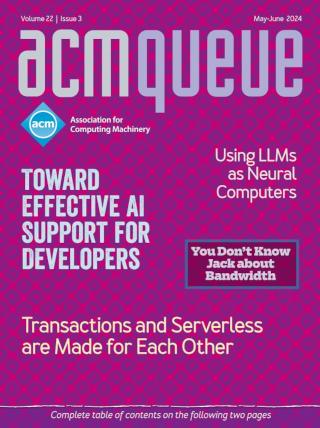
The SPACE of Developer Productivity:
There's more to it than you think.
Developer productivity is about more than an individual's activity levels or the efficiency of the engineering systems relied on to ship software, and it cannot be measured by a single metric or dimension. The SPACE framework captures different dimensions of productivity, and here we demonstrate how this framework can be used to understand productivity in practice and why using it will help teams better understand developer productivity and create better measures to inform their work and teams.
Toward Confidential Cloud Computing:
Extending hardware-enforced cryptographic protection to data while in use
Although largely driven by economies of scale, the development of the modern cloud also enables increased security. Large data centers provide aggregate availability, reliability, and security assurances. The operational cost of ensuring that operating systems, databases, and other services have secure configurations can be amortized among all tenants, allowing the cloud provider to employ experts who are responsible for security; this is often unfeasible for smaller businesses, where the role of systems administrator is often conflated with many others.
WebRTC - Realtime Communication for the Open Web Platform:
What was once a way to bring audio and video to the web has expanded into more use cases we could ever imagine.
In this time of pandemic, the world has turned to Internet-based, RTC (realtime communication) as never before. The number of RTC products has, over the past decade, exploded in large part because of cheaper high-speed network access and more powerful devices, but also because of an open, royalty-free platform called WebRTC. WebRTC is growing from enabling useful experiences to being essential in allowing billions to continue their work and education, and keep vital human contact during a pandemic. The opportunities and impact that lie ahead for WebRTC are intriguing indeed.
Aversion to Versions:
Resolving code-dependency issues
One should never hardcode a version or a path inside the code itself. Code needs to be flexible so that it can be installed anywhere and run anywhere so long as the necessary dependencies can be resolved, either at build time for statically compiled code or at runtime for interpreted code or code with dynamically linked libraries. There are current, good ways to get this right, so it's a shame that so many people continue to get it wrong.
Software Development in Disruptive Times:
Creating a software solution with fast decision capability, agile project management, and extreme low-code technology
In this project, the challenge was to "deploy software faster than the coronavirus spread." In a project with such peculiar characteristics, several factors can influence success, but some clearly stand out: top management support, agility, understanding and commitment of the project team, and the technology used. Conventional development approaches and technologies would simply not be able to meet the requirements promptly.
Fail-fast Is Failing... Fast!:
Changes in compute environments are placing pressure on tried-and-true distributed-systems solutions.
For more than 40 years, fail-fast has been the dominant way of achieving fault tolerance. In this approach, some mechanism is responsible for ensuring that each component is up, functioning, and responding to work. As the industry moves to leverage cloud computing, this is getting more challenging. The way we create robust solutions is under pressure as the individual components don't fail fast but instead, starts running slow, which is far worse The slow component may be healthy enough to say, "I'm still here!" but slow enough to clog up all the work. This makes fail-fast schemes vulnerable.





